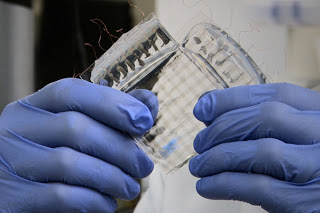Stanford University – Using carbon nanotubes bent to act as springs, Stanford researchers have developed a stretchable, transparent skin-like sensor. The sensor can be stretched to more than twice its original length and bounce back perfectly to its original shape. It can sense pressure from a firm pinch to thousands of pounds. The sensor could have applications in prosthetic limbs, robotics and touch-sensitive computer displays.
When the nanotubes are airbrushed onto the silicone, they tend to land in randomly oriented little clumps. When the silicone is stretched, some of the “nano-bundles” get pulled into alignment in the direction of the stretching.
When the silicone is released, it rebounds back to its original dimensions, but the nanotubes buckle and form little nanostructures that look like springs.
“After we have done this kind of pre-stretching to the nanotubes, they behave like springs and can be stretched again and again, without any permanent change in shape,” Bao said.
The sensor is stretchy in all directions and then rebounds to the original shape.
Transparent, elastic conductors are essential components of electronic and optoelectronic devices that facilitate human interaction and biofeedback, such as interactive electronics, implantable medical devices and robotic systems with human-like sensing capabilities. The availability of conducting thin films with these properties could lead to the development of skin-like sensors that stretch reversibly, sense pressure (not just touch), bend into hairpin turns, integrate with collapsible, stretchable and mechanically robust displays and solar cells, and also wrap around non-planar and biological surfaces such as skin and organs, without wrinkling. We report transparent, conducting spray-deposited films of single-walled carbon nanotubes that can be rendered stretchable by applying strain along each axis, and then releasing this strain. This process produces spring-like structures in the nanotubes that accommodate strains of up to 150% and demonstrate conductivities as high as 2,200 S cm−1 in the stretched state. We also use the nanotube films as electrodes in arrays of transparent, stretchable capacitors, which behave as pressure and strain sensors.
Use of stretchable nanotube films in compressible capacitors that can sense pressure and strain.
The sensors consist of two layers of the nanotube-coated silicone, oriented so that the coatings are face-to-face, with a layer of a more easily deformed type of silicone between them.
The middle layer of silicone stores electrical charge, much like a battery. When pressure is exerted on the sensor, the middle layer of silicone compresses, which alters the amount of electrical charge it can store. That change is detected by the two films of carbon nanotubes, which act like the positive and negative terminals on a typical automobile or flashlight battery.
The change sensed by the nanotube films is what enables the sensor to transmit what it is “feeling.”
Whether the sensor is being compressed or extended, the two nanofilms are brought closer together, which seems like it might make it difficult to detect which type of deformation is happening. But Lipomi said it should be possible to detect the difference by the pattern of pressure.
With compression, you would expect to see sort of a bull’s-eye pattern, with the greatest deformation at the center and decreasing deformation as you go farther from the center.
“If the device was gripped by two opposing pincers and stretched, the greatest deformation would be along the straight line between the two pincers,” Lipomi said. Deformation would decrease as you moved farther away from the line.
Bao’s research group previously created a sensor so sensitive to pressure that it could detect pressures “well below the pressure exerted by a 20 milligram bluebottle fly carcass” that the researchers tested it with. This latest sensor is not quite that sensitive, she said, but that is because the researchers were focused on making it stretchable and transparent.
“We did not spend very much time trying to optimize the sensitivity aspect on this sensor,” Bao said.
“But the previous concept can be applied here. We just need to make some modifications to the surface of the electrode so that we can have that same sensitivity.”
10 pages of supplemental information
If you liked this article, please give it a quick review on ycombinator or StumbleUpon. Thanks

Brian Wang is a Futurist Thought Leader and a popular Science blogger with 1 million readers per month. His blog Nextbigfuture.com is ranked #1 Science News Blog. It covers many disruptive technology and trends including Space, Robotics, Artificial Intelligence, Medicine, Anti-aging Biotechnology, and Nanotechnology.
Known for identifying cutting edge technologies, he is currently a Co-Founder of a startup and fundraiser for high potential early-stage companies. He is the Head of Research for Allocations for deep technology investments and an Angel Investor at Space Angels.
A frequent speaker at corporations, he has been a TEDx speaker, a Singularity University speaker and guest at numerous interviews for radio and podcasts. He is open to public speaking and advising engagements.



